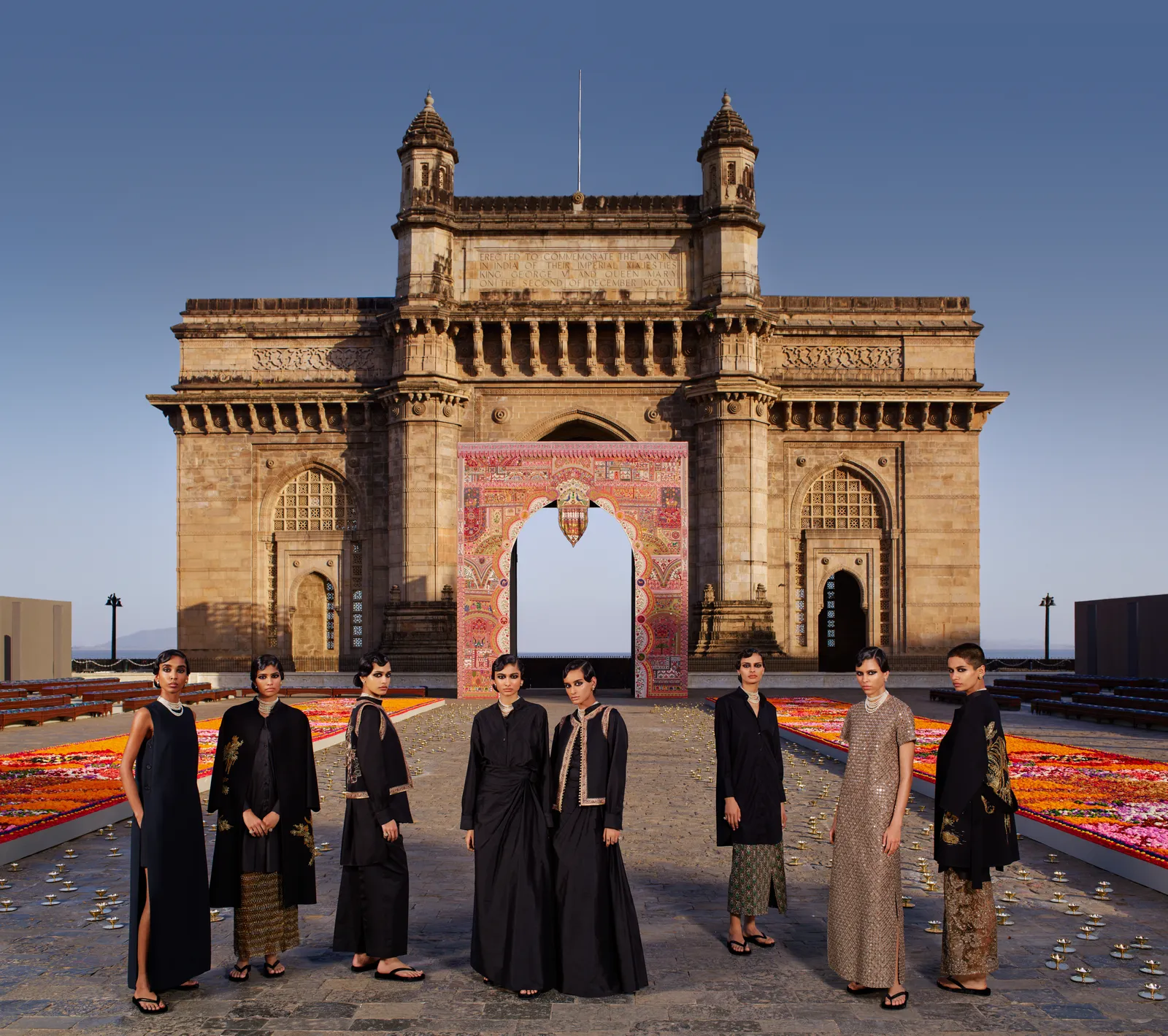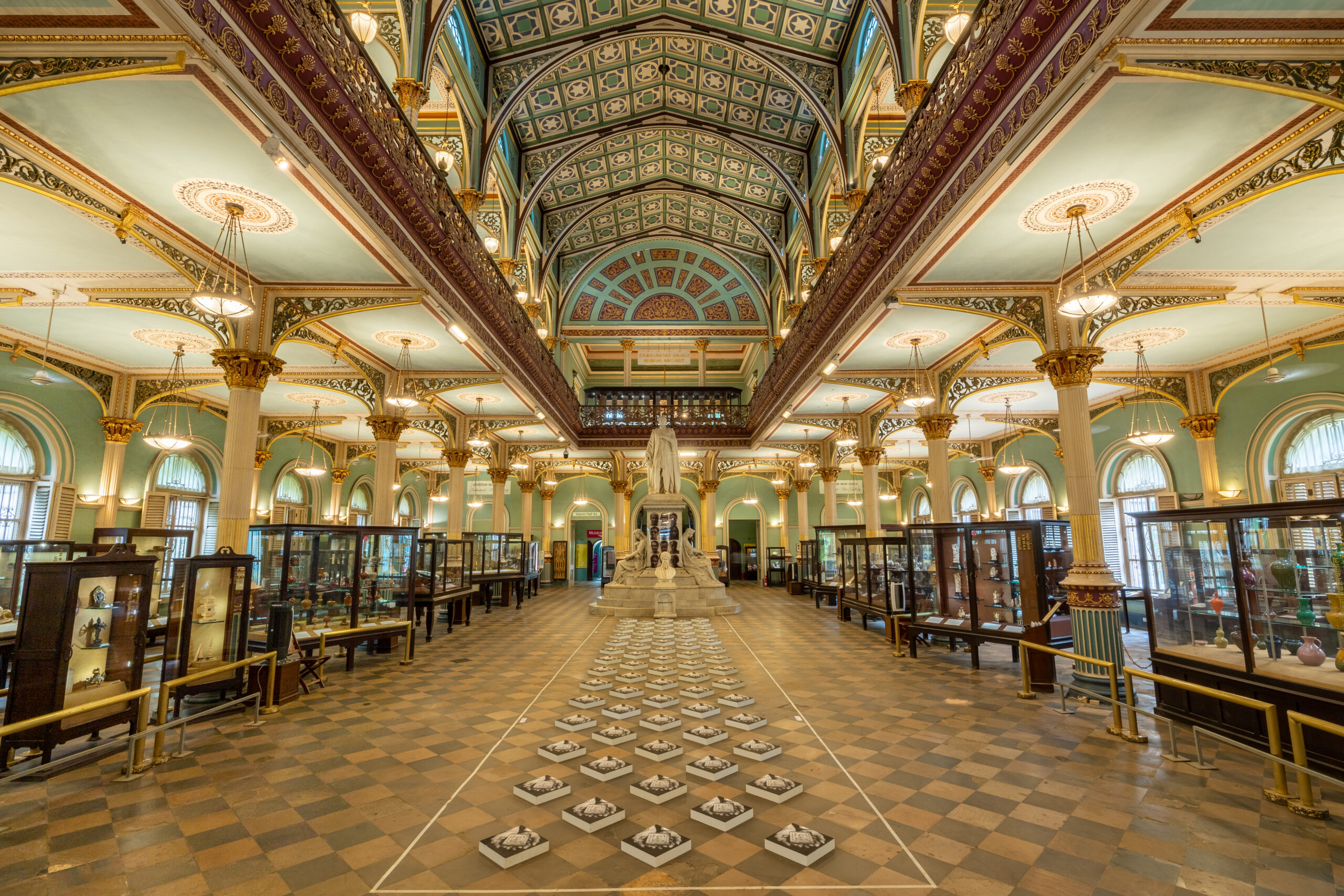From Mumbai’s lively streets to Parisian opulence, Indian designers astound are leaving an indelible mark on the fashion universe with every exquisite creation. With each passing season, Indian designers gain momentum, fueled by the world’s growing appetite for slow and artisanal fashion. The once-niche market has blossomed into an industry brimming with possibilities, thanks to the growing demand for the craft of Indian designers. No longer confined to the periphery, Indian designers are rising to international acclaim, drawing on the resplendent craftsmanship they grew up cherishing and their profound connection to the country’s roots. With a nod to tradition and a vision that stretches far beyond borders, Indian designers are poised to etch their mark on the global fashion landscape.
Recently, London’s renowned Design Museum made history by presenting a groundbreaking exhibition titled “The Offbeat Sari”, delving deep into the essence of the iconic and versatile garment. This exhibit showcased the exceptional craftsmanship of over 60 contemporary Indian designers, signifying a moment of triumph and recognition for the Indian fashion community.
The Offbeat Sari exhibition at the Design Museum, London
While Gaurav Gupta made his Paris debut earlier this year and stunned the fashion industry, Rahul Mishra continued his participation in the prestigious Paris Couture Week for the seventh time in a row. A significant milestone has been reached because this is the first time two Indian designers have returned to the prestigious Paris Couture Week official calendar, which was held in July.
Rahul Mishra, who has dressed celebrities like Zendaya, Esther Yu, Zinnia Kumar, passionately speaks about the flourishing scene in India, considering it the most thrilling place for a fashion designer today. He highlights the incredible acceptance and acknowledgement Indian craftsmanship is currently receiving, a phenomenon that stands unparalleled.
The economic prosperity of India, with an impressive GDP of $3.74 trillion, making it the fifth largest economy, has piqued the interest of international fashion brands, leading them to invest significantly in the Indian market. The confluence of global recognition and economic growth, along with a rich cultural heritage has elevated Indian fashion, making it an exciting and dynamic industry for designers and enthusiasts alike.
Gaurav Gupta Couture.
India’s extraordinary craftsmanship and artisans commitment to their heritage has paved a path for a flourishing couture industry among it’s native designers. The ongoing, prestigious 16th edition of the India Couture Week, hosted by the FDCI, features the participation of 15 talented designers. This grand event which pays homage to the talent that India is brimming with, and gives a platform to Indian designers to showcase their unique creations, could serve as a stepping stone for Indian couture labels to showcase their artistry at prominent global events, including those in Paris, the fashion capital of the world.
India’s diverse cultural heritage boasts a treasury of unparalleled craft traditions, ranging from captivating block printing to intricate beadwork. The new generation of indigenous designers are poised to take those precious legacies to the world stage with a contemporary flair. The artistic fusion with Matchesfashion, a UK-based e-commerce platform that collaborates with several India-made contemporary labels, including Lovebirds, D’Ascoli, and Harago. Liane Wiggins, head of womenswear at Matchesfashion, reveals that their global clientele appreciates the artistry and dedication that goes into crafting collections, which harmonizes perfectly with the work of Indian designers and their artisanal craftsmanship.
Artisans and Couturiers painstakingly hand-sew details at the Rahul Mishra Atelier.
In the realm of luxury fashion, revered brands like Dior, Valentino, and Chanel have long relied on the expertise of Indian ateliers to create their exquisite garments. However, the exceptional artisanship of these Indian craftsmen has often remained unrecognised until recently. A significant shift occurred when Dior’s pre-fall show took place in Mumbai, shedding a spotlight on the local industry’s masterful craftsmanship through a collaborative partnership with the esteemed Indian textile house, Chanakya International. Maria Grazia Chiuri, Dior’s creative director, openly acknowledged the fashion houses’ enduring collaboration with Indian craftspeople, particularly praising the impeccable haute couture savoir-faire demonstrated by the Chanakya School of Craft. Dior’s collaboration with Chanakya School of Craft goes beyond the pre-fall show.
Dior and Chanakya recently came together to pay homage to Indian craftsmanship and India’s rich heritage. The awe-spiring collection showcased the unmistakable essence of Dior while keeping the hues of the Indian spirit vibrant. Mumbai’s iconic “Gateway of India”, an architectural and historical maven, was a background in the unveiling of the collection. While the show celebrated Indian artisans, it also strengthened the creative amalgamation between India and France.
Helming the spirit of artistry, a handcrafted 10-metre Toran, gracefully merging with the timeless allure of the Gateway of India and two bespoke fresh flower carpets sprawled like vibrant tapestries, spanning an awe-inspiring 115 feet on either side. The convergence of creativity and splendour left spectators spellbound, a perfect blend of Indian heritage with a hint of Parisian elegance, was produced by Seventy EMG, an Indian company.
Models pose in front of the Dior Fall 2023 show runway at Gateway of India, Mumbai.
Beyond fashion houses, Indian designers have garnered attention and adoration from global celebrities. Over the past two years, designer Gaurav Gupta has emerged as one of the most sought-after names for red carpet attire, dressing international stars like Cardi B, Megan Thee Stallion, and Catrinel Marlon, amongst others, for iconic events like the Cannes Red Carpet.
Mumbai-based duo Shane and Falguni Peacock have also made waves, dressing activist Malala Yousafzai, comedian Mindy Kaling, and international stars like Beyonce. Their upcoming showcase at New York Fashion Week further solidifies their status on the international fashion scene.
The star-studded allure of these Indian designers has translated into worldwide expansions. Manish Malhotra, a beloved designer among Bollywood celebrities renowned for his intricate wedding wear, is set to open a colossal flagship store in Dubai Mall’s coveted luxury section later in the summer. Anita Dongre, another prominent designer, has already established a flagship store in Dubai Mall, strategically positioned across from Galerie Lafayette, following her success with a store in New York for the past six years.
Interiors of the Anita Dongre store in Dubai Mall.
In a bold move, Kolkata’s Sabyasachi Mukherjee inaugurated his flagship store in New York’s West Village last fall, having previously stocked his label at renowned fashion destinations like Browns, Bergdorf Goodman, and Selfridges. The opening of his store drew immense crowds, with eager customers lining up around the corner to experience his captivating designs. The contemporary label Ranna Gill made a splash by unveiling a new boutique in the Hamptons in May, catering to the fashion-forward clientele in that vibrant locale.
Securing international expansion becomes more feasible with adequate financial support. For Anita Dongre, the backing she received in 2013 from the American private equity fund General Atlantic played a pivotal role in facilitating her move to New York. However, the landscape in India has been less conducive to fashion designers seeking funding, with investors historically hesitant to venture into the fashion sector, but times have changed since investors and the global market have taken note of India’s growing economy and its expansive and innovative fashion scene.
Interiors of the Sabyasachi store in New York.
In recent times, two of India’s largest conglomerates, Reliance Industries Limited and Aditya Birla Group, have been on a noteworthy acquisition spree. They have invested in prominent designer labels such as Ritu Kumar, Abu Jani Sandeep Khosla, Manish Malhotra, Sabyasachi Mukherjee, Rahul Mishra, Tarun Tahiliani, and Masaba Gupta. This corporate involvement in the fashion industry has granted designers the freedom to experiment and venture into global markets, as pointed out by Sunil Sethi, the president of the Fashion and Design Council of India (FDCI). And these bold experiments have proven successful, as an international audience now embraces the artisanal offerings from a country renowned for its exquisite handwork.
The new generation of homegrown designers is now poised to harness this heritage and infuse it with a global sensibility. Anita Dongre emphasises that Indian designers possess a unique advantage, as they wield these traditional techniques with an imaginative flair rooted in generations of familiarity with these art forms. Their global fashion vocabulary is shaped by the rich craft history they grew up with and their deep-rooted connection to grassroots realities. Dongre believes that this fusion can spill over into contemporary fashion, adding to its allure.
Behind the dazzling glamour of couture lies an economic force that fuels India’s fashion ascent. With the country’s flourishing economy and growing luxury industry, international investors are increasingly drawn to India’s creative potential. As the nation’s fashion landscape evolves, it beckons global brands to join hands with local artisans, embracing the artistry that India has cultivated for centuries.
Words by Esha Aphale.
Cover image Courtesy of Gaurav Gupta.
Image credits Gaurav Gupta, Sabyasachi, Tarun Tahiliani, Getty Images.















